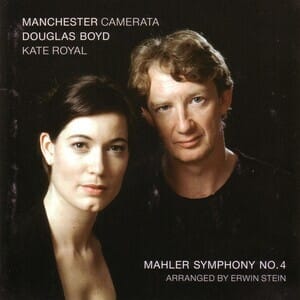- Gathering Note
- Posts
- Chamber sized Mahler is part of “Romancing the Muse”
Chamber sized Mahler is part of “Romancing the Muse”

It isn’t surprising Erwin Stein picked Mahler’s Fourth Symphony to reduce for chamber ensemble for performance in Schoenberg’s Society of Private Musical Performance. The symphony is Mahler’s smallest in scope even if the impetus is other-worldly. As with all of Mahler’s symphonies, the composer sought to encompass themes larger than himself even if they are somewhat obscured. On the one hand, there are moments of childlike innocence suggesting naive love. This is the approach embraced by the Northwest Sinfonietta’s music director Christoph Chagnard. An alternative view, is that the symphony reveals the infinite pleasures of heaven, exemplified by the fourth movement — a setting of “the Heavenly Life” for soprano from the Youth’s Magic Horn.
Two days before Valentine’s Day, Christoph Chagnard and the Northwest Sinfonietta performed Stein’s reduction of Mahler’s Fourth Symphony as part of their concert “Romancing the Muse.” Although the symphony was the heart of the concert, Chagnard preceded the reduced piece with a series of arias that explored the theme of love.
Soprano Lambroula Pappas, who also sang in the final movement of the Fourth Symphony, joined the ensemble for four Mozart arias. At the start of the second half, Chagnard explained that each dealt with a different type of love. Tucked between the four arias, was Gabriel Faure’s “Romance Without Words,” an instrumental song prominently featuring Mara Finkelstein’s beautiful tone and technical finesse on the cello.
In the arias, Pappas’ vocal line was achingly beautiful. Pappas’ demonstrated absolute control over the arias singing them from memory and with the confidence you would expect from a singer as experienced as she is. Pappas is a practiced operatic singer who has also sung extensively with orchestras across Canada. Because of her dual experience singing opera and with orchestras, she was the right choice for Friday’s concert. She was also the right choice because her voice was the perfect size for the Nordstrom Recital Hall. It filled the space without dominating the space.
Hearing Stein’s reduction of Mahler’s symphony was a unique experience. So unique, that it is very likely Friday’s performance was the Northwest premiere of the piece. For all its uniqueness, hearing Mahler played with the significantly reduced forces (only twelve instrumentalists were used) of the Northwest Sinfonietta was disconcerting. Gone were brass instruments and timpani. The trumpet solo in the first movement foreshadowing the Fifth Symphony was tackled by the oboe. The timpani’s load was carried by the piano. The complex colors and harmonies found in the symphonies with arrangements of musicians playing together and off one another, were substituted with lean textures and chamber music simplicity from start to finish.
The piece’s chamber music size worked for and against the musicians. With only a handful of instruments, Mahler’s ideas were uncommonly transparent. With the smaller forces, Chagnard was able to push tempos. The conductor didn’t allow any dawdling. But using fewer instruments came at a price too. In this case, errors that would have gone undetectable in a crowd of eighty musicians stood out.
Stein’s re-orchestration of the piece effectively eliminated the grandeur of the symphony. While it is true, the Fourth is Mahler’s most compact symphony, that doesn’t mean it is short on affecting music. Its strength as music, comes from the steady build up to the fourth movement’s angelic revelations. Of the Fourth’s three instrumental movements, the third movement is (in my opinion) the composer’s best slow movement. The movement gives listeners tantalizing glimpses at the heavenly beyond replicated in music by yearning crescendos and decrescendos. With twelve instruments, however, this build up sounded emotionless and intermittently cartoonish.
In the fourth movement, the piece found its footing when Pappas returned to sing. Her voice was as sweet and even as it was during the first half’s arias. For my ears, she didn’t capture the innocent love of a child so much as her singing exemplified the promise of heaven.
Chagnard and his musicians did their best with the piece. They played well as a group, sounding generally tight and well balanced. They tried to make this smaller version of the Fourth Symphony match its larger progeny. When the piece didn’t work, it was because of Stein’s reduction and not Chagnard’s leadership or the musicians’ playing. In fact, because of Chagnard’s obvious comfort with Mahler’s music, I hope he considers tackling the Fourth with one of his other orchestras.
Over the course of one hundred concerts and nearly 200 pieces, Schoenberg’s Society of Private Musical Performance featured music from countless composers. This elite musical club was a salon for the most challenging music of the new century as well as large scale music reduced to more modest dimensions. Erwin Stein’s reduction of Mahler’s Fourth Symphony falls into this later category. Stein’s re-orchestration provided a new way for Friday’s audience to hear Mahler’s Fourth Symphony. I am grateful northwest audiences got to hear this rarity and experience its chamber-sized merits. Nevertheless, my ears still prefer Mahler’s own orchestration of the symphony — good things don’t always come in small packages.